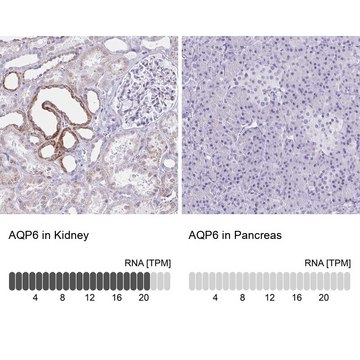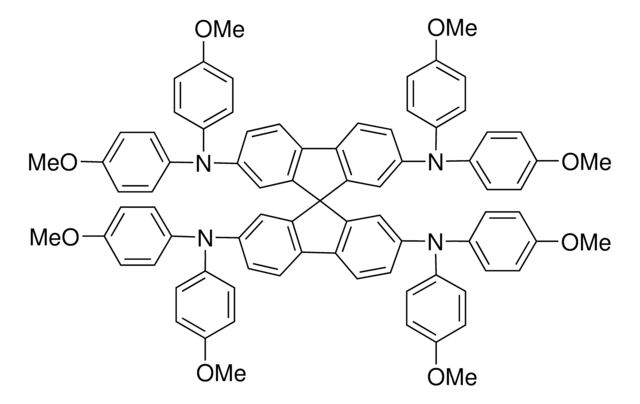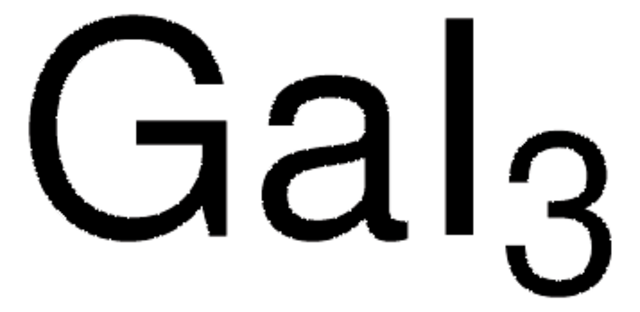AB3073
Anti-Aquaporin 6 Antibody, kidney specific form
Chemicon®, from rabbit
Sign Into View Organizational & Contract Pricing
All Photos(1)
Synonym(s):
AQP6, AQP2L
UNSPSC Code:
12352203
eCl@ss:
32160702
NACRES:
NA.41
Recommended Products
biological source
rabbit
Quality Level
antibody form
affinity purified immunoglobulin
antibody product type
primary antibodies
clone
polyclonal
purified by
affinity chromatography
species reactivity
human
manufacturer/tradename
Chemicon®
technique(s)
ELISA: suitable
western blot: suitable
NCBI accession no.
UniProt accession no.
shipped in
dry ice
target post-translational modification
unmodified
Gene Information
human ... AQP6(363)
General description
Water is a critical component of all living cells. Interestingly, tissue membranes show a great degree of water permeability. Mammalian red cells, renal proximal tubules, and descending thin limb of Henle are extraordinarily permeable to water. Water crosses hydrophobic plasma membranes either by simple diffusion or through a facilitative transport mechanism mediated by special protein "aquaporin". Over the last decade, genes for several members of aquaporin family have been cloned, expressed, and their distribution studied in many tissues. Aquaporin-0 or MIP26 (major intrinsic protein 26 kDa), and Aquaporin-1 (purified from red cells) also called CHIP-28 (channel forming integral protein, 28 kDa; 268 AA; gene locus 7p14) has been the foundation of the growing family of aquaporins. The lens specific Aquaporin-0 represents up to 80% of total lens membrane protein. Defects in MIP26 are a cause of autosomal dominant cataract. The cataract Fraser mutation (CAT-FR or Shriveled) is a transposon-induced splicing error that substitutes a long terminal repeat sequence for the c-terminus of MIP. The lens opacity mutation (LOP) is an AA substitution that inhibits targeting of MIP to the cell membrane. Aquaporin-6 (WCH3 or hKID or AQP2-like; 282 aa; 29 kDa; chromosome 12q13) is found only in the kidney with low water permeability. Aquaporin families of proteins are predicted to contain six transmembrane domains. The N and C-terminus are predicted to be cytoplasmic. Aquaporin-6 shows greatest homology with hMIP (48%) and hAQP-2 (52%). It also has similarity with human MIWC (AQP4; 34%), CHIP-28 (AQP1; 38%), and GLIP (AQP3; 22%).
Specificity
Water is a critical component of all living cells. Interestingly, tissue membranes show a great degree of water permeability. Mammalian red cells, renal proximal tubules, and descending thin limb of Henle are extraordinarily permeable to water. Water crosses hydrophobic plasma membranes either by simple diffusion or through a facilitative transport mechanism mediated by special protein "aquaporin". Over the last decade, genes for several members of aquaporin family have been cloned, expressed, and their distribution studied in many tissues. Aquaporin-0 or MIP26 (major intrinsic protein 26 kDa), and Aquaporin-1 (purified from red cells) also called CHIP-28 (channel forming integral protein, 28 kDa; 268 AA; gene locus 7p14) has been the foundation of the growing family of aquaporins. The lens specific Aquaporin-0 represents up to 80% of total lens membrane protein. Defects in MIP26 are a cause of autosomal dominant cataract. The cataract Fraser mutation (CAT-FR or Shriveled) is a transposon-induced splicing error that substitutes a long terminal repeat sequence for the c-terminus of MIP. The lens opacity mutation (LOP) is an AA substitution that inhibits targeting of MIP to the cell membrane. Aquaporin-6 (WCH3 or hKID or AQP2-like; 282 aa; 29 kDa; chromosome 12q13) is found only in the kidney with low water permeability. Aquaporin families of proteins are predicted to contain six transmembrane domains. The N and C-terminus are predicted to be cytoplasmic. Aquaporin-6 shows greatest homology with hMIP (48%) and hAQP-2 (52%). It also has similarity with human MIWC (AQP4; 34%), CHIP-28 (AQP1; 38%), and GLIP (AQP3; 22%)
Immunogen
A 19 AA synthetic peptide within the carboxy terminal domain of human AQP6 (Ma et al. 1996) was selected for antibody production. This domain is predicted to be cytoplasmic.
Epitope: kidney specific form
Application
Anti-Aquaporin 6 Antibody, kidney specific form is an antibody against Aquaporin 6 for use in ELISA & WB.
Research Category
Neuroscience
Neuroscience
Research Sub Category
Ion Channels & Transporters
Ion Channels & Transporters
Western blot: 1-10 μg/mL using Chemiluminescence technique Immunohistochemistry: We recommend using the affinity purified antibody at 2-10 μg/mL in paraformaldehyde fixed sections of tissues.
ELISA: 0.5-1.0 μg/mL
Optimal working dilutions must be determined by end user.
ELISA: 0.5-1.0 μg/mL
Optimal working dilutions must be determined by end user.
Physical form
Affinity Purified immunoglobulin in PBS containing 0.1% BSA as stabilizer. No preservative.
Storage and Stability
Maintain frozen at -20°C in undiluted aliquots for up to 12 months.
Other Notes
Concentration: Please refer to the Certificate of Analysis for the lot-specific concentration.
Legal Information
CHEMICON is a registered trademark of Merck KGaA, Darmstadt, Germany
Disclaimer
Unless otherwise stated in our catalog or other company documentation accompanying the product(s), our products are intended for research use only and are not to be used for any other purpose, which includes but is not limited to, unauthorized commercial uses, in vitro diagnostic uses, ex vivo or in vivo therapeutic uses or any type of consumption or application to humans or animals.
WGK
WGK 2
Certificates of Analysis (COA)
Search for Certificates of Analysis (COA) by entering the products Lot/Batch Number. Lot and Batch Numbers can be found on a product’s label following the words ‘Lot’ or ‘Batch’.
Already Own This Product?
Find documentation for the products that you have recently purchased in the Document Library.
Maria V Yusenko et al.
International journal of biological sciences, 5(6), 517-527 (2009-08-15)
Due to overlapping morphology, malignant chromophobe renal cell carcinomas (RCC) and benign renal oncocytomas (RO) may pose a diagnostic problem. In the present study, we have applied different algorithms to evaluate the data sets obtained by hybridisation of pooled and
Andrea Molinas et al.
Frontiers in cell and developmental biology, 5, 98-98 (2017-12-07)
Normal epithelial and endothelial renewal and healing after bacterial and viral challenges are essential for homeostasis along the intestine and the blood and lymphatic vessels. We thus investigated whether and how virus affects migration of human epithelial cells and specifically
Our team of scientists has experience in all areas of research including Life Science, Material Science, Chemical Synthesis, Chromatography, Analytical and many others.
Contact Technical Service





